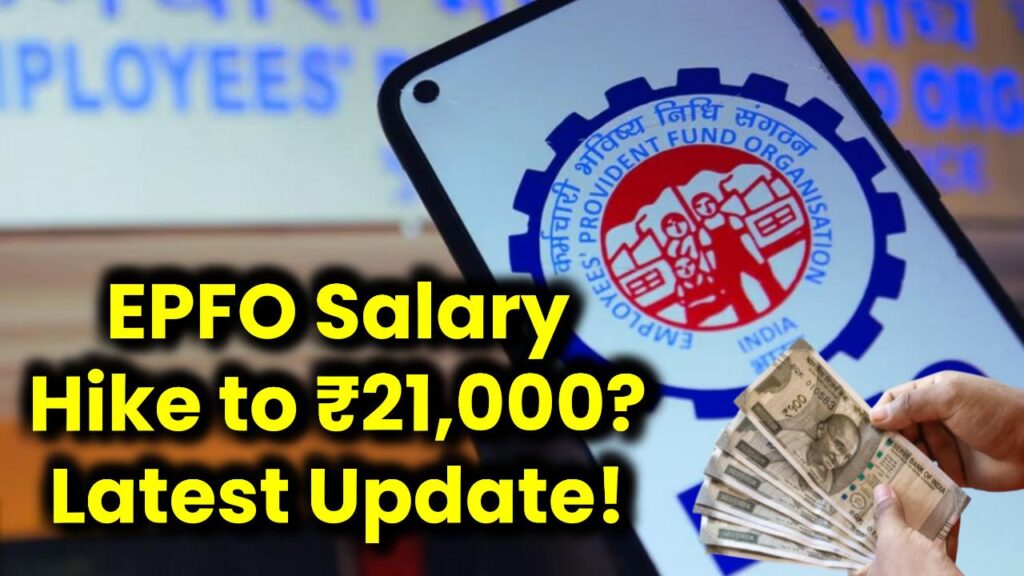
EPFO Salary Hike: The Indian government is considering an increase in the Employees’ Provident Fund Organization (EPFO) salary ceiling from ₹15,000 to ₹21,000. This potential move could significantly impact millions of employees and employers across the country, offering better social security coverage and enhanced retirement benefits.
With more employees falling under the EPF scheme, this proposed salary hike aims to improve financial security while also posing some additional financial responsibilities for employers.
EPFO Salary Hike
| Aspect | Details |
|---|---|
| Current EPF Salary Ceiling | ₹15,000/month |
| Proposed EPF Salary Ceiling | ₹21,000/month |
| Additional Employees Covered | ~7.5 million |
| Employer’s Contribution to EPS | Increase from ₹1,250 to ₹1,749/month |
| Retirement Corpus Impact | Potential increase to ~₹1 crore over 35 years |
| Government’s Objective | Expand social security coverage & boost retirement savings |
| Official Source | EPFO Official Website |
The proposed EPFO salary ceiling hike to ₹21,000 is a significant move aimed at enhancing social security for employees. It will help millions of workers secure better retirement savings but will also increase the financial burden on employers. While this change is still under discussion, employees and businesses must prepare for its potential impact.
Why is the EPFO Salary Hike Being Considered?
The Employees’ Provident Fund (EPF) is a crucial social security initiative aimed at ensuring financial stability for workers after retirement. Currently, only employees earning up to ₹15,000 per month are mandatorily covered under EPF. This limit was set in 2014, and since then, salaries and the cost of living have risen significantly.
By increasing the limit to ₹21,000, the government aims to extend EPF benefits to more employees, helping them save more for retirement. Additionally, this change will increase the pension payouts for those under the Employees’ Pension Scheme (EPS).
Who Will Benefit from EPFO Salary Hike?
Employees:
- Workers earning between ₹15,000 and ₹21,000 who were previously not eligible will now receive EPF and EPS benefits.
- Employees will accumulate a larger retirement corpus, helping them secure a stable financial future.
- The increase in EPS contributions will result in higher pension payouts.
Employers:
- Companies with employees earning below ₹21,000 will need to increase their contributions, potentially leading to higher operational costs.
- Businesses will need to update their payroll systems to accommodate the new salary threshold.
- Firms employing contract workers or daily wage earners might see compliance changes.
22,000 EPFO Members to Receive Higher Pension – How to Check Your Updated Pension?
EPS new rules: Now You Can Withdraw Your EPF Pension from ANY Bank
How the EPF and EPS Contributions Work
Breakdown of EPF and EPS Contributions
| Component | Employee’s Contribution | Employer’s Contribution |
| EPF (12%) | 12% of basic salary | 3.67% of basic salary |
| EPS (8.33%) | N/A | 8.33% (up to ceiling) |
- With the revised salary cap of ₹21,000, the EPS contribution will rise from ₹1,250 to ₹1,749.
- The total retirement corpus will increase, as both employee and employer contributions will be higher.
Financial Impact of the Salary Hike on Employees
Example Scenario
An employee earning ₹21,000 per month will see the following changes:
- EPF contribution (12%): ₹2,520 per month (employee share)
- Employer’s EPF share (3.67%): ₹770 per month
- Employer’s EPS share (8.33%): ₹1,749 per month
- Total annual EPF savings (without interest): ₹60,480
- Over 35 years, assuming an 8.25% annual interest rate, the total EPF corpus could reach ₹1 crore or more.
Challenges and Considerations
For Employees:
- Reduced take-home salary due to increased deductions.
- Higher long-term benefits, but immediate impact on disposable income.
- More security in retirement planning with increased pension payouts.
For Employers:
- Higher labor costs, leading to potential financial strain, especially for small and medium enterprises (SMEs).
- Payroll adjustments and compliance updates required.
- Possible reduction in hiring or restructuring of salary structures to mitigate increased costs.
Impact on the Economy
- Boost in national savings rate as more employees contribute to EPF.
- Greater financial security for the workforce, reducing dependency on government schemes in the future.
- Potential slowdown in hiring, especially in labor-intensive industries.
FAQs On EPFO Salary Hike
1. When will the EPFO salary ceiling increase to ₹21,000?
As of now, the proposal is under consideration. It is expected to be finalized soon, depending on government approval and implementation policies.
2. Will all employees earning below ₹21,000 be automatically covered?
Yes, if the new rule is approved, all employees earning up to ₹21,000 will be mandatorily enrolled under EPF and EPS.
3. How will this affect my take-home salary?
While the EPF deductions will be higher, they go towards your savings, ensuring financial security in the long run.
4. Will the employer’s contribution increase as well?
Yes, employers will contribute more towards EPS and EPF, impacting their overall payroll expenses.
5. Can I opt out of EPF if my salary is below ₹21,000?
No, EPF is mandatory for employees earning below the threshold. However, employees earning above this limit can opt out if they do not contribute initially.







